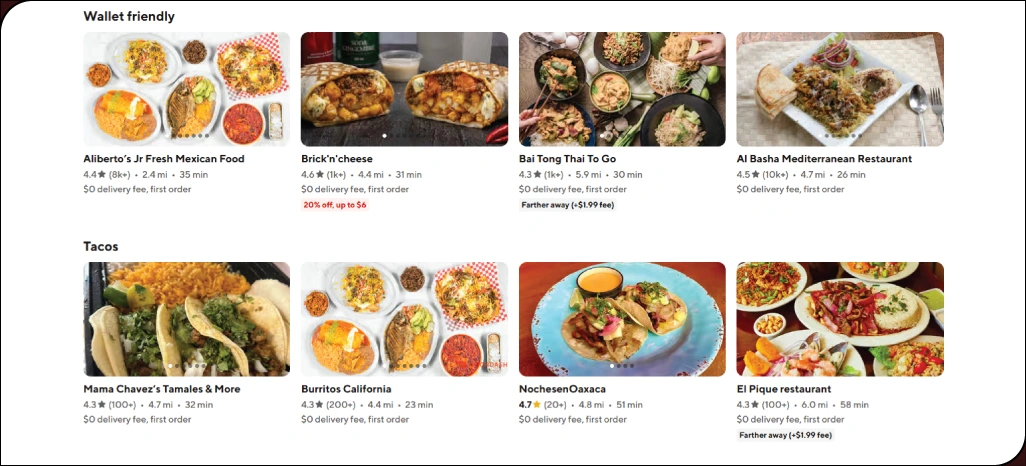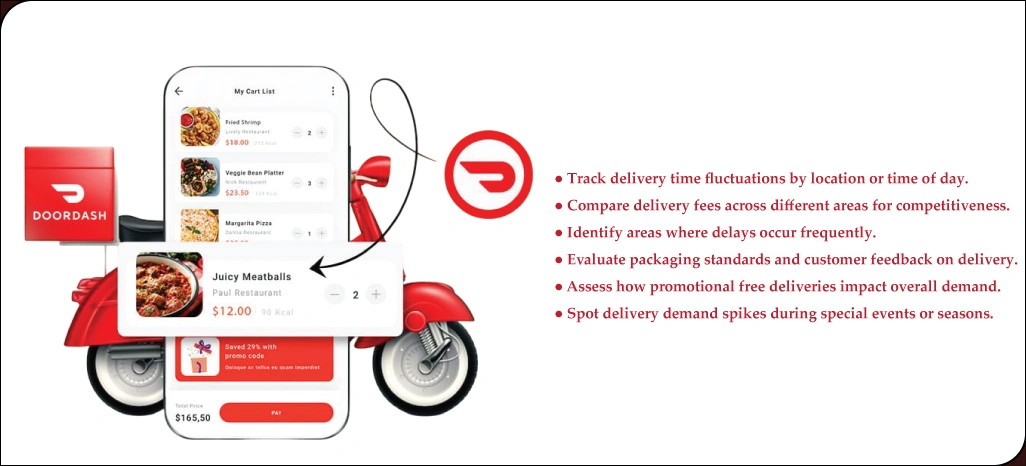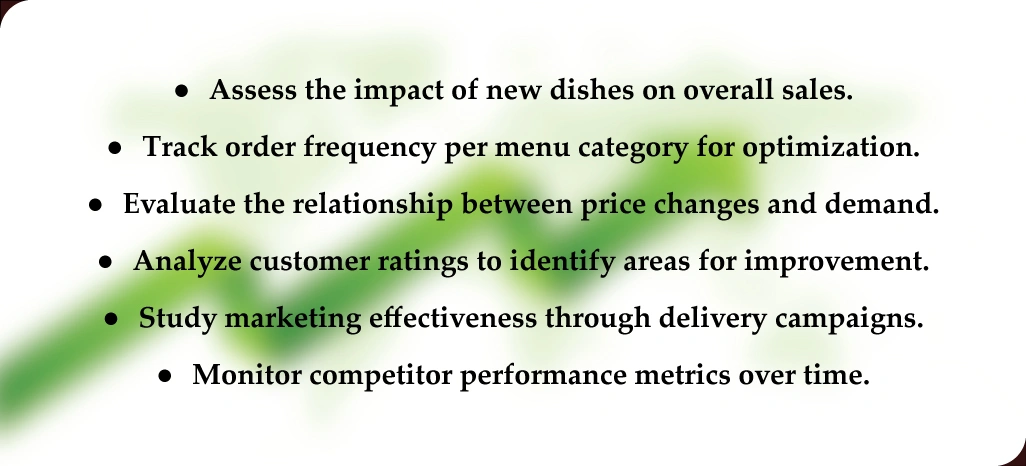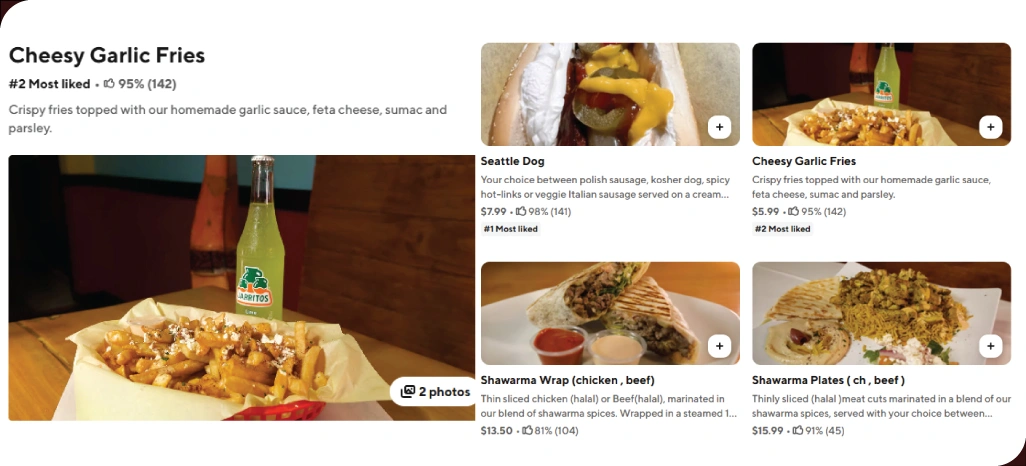What Role Does DoorDash Data Scraping Play in Unlocking Restaurant Menu and Delivery Analytics?

Introduction
The food delivery industry has undergone a rapid transformation, with apps like DoorDash leading the way in reshaping how consumers order meals and how restaurants operate. To remain competitive in this evolving market, restaurants, aggregators, and analysts need accurate data-driven insights into menus, pricing, and delivery trends. This is where DoorDash Data Scraping plays a vital role. By automating the extraction of valuable data, businesses can streamline their decision-making and design more customer-focused strategies.
One of the most critical aspects of food platforms is the vast volume of information they host. From menu details and prices to delivery fees, ratings, and customer reviews, this data becomes a goldmine when used correctly. With Food Data Scraping, companies can capture, clean, and analyze this information to identify trends, track competitors, and enhance customer experiences.
Whether a restaurant wants to monitor its competitors’ promotions or a delivery startup aims to understand how pricing impacts demand, the correct data makes all the difference. With consistent access to well-structured datasets, businesses gain the flexibility to align their offerings with market shifts and customer expectations. Ultimately, this establishes a solid foundation for informed growth and enduring brand positioning in a highly competitive industry.
Tracking Menu Trends and Pricing Strategies
Understanding how menus evolve is crucial for restaurants and food delivery platforms. Through DoorDash Menu Scraper tools, businesses can extract structured menu information, including dish names, ingredients, portion sizes, and pricing. This enables them to track shifts in consumer preferences and identify pricing strategies that resonate with specific demographics.
- Monitor menu changes across competing restaurants to evaluate new offerings.
- Compare pricing trends to determine if items are competitively aligned.
- Spot seasonal food trends and evaluate their popularity.
- Identify upselling strategies such as combos and meal deals.
- Track the availability of items to assess the impact of supply and demand on your business.
- Analyze portion sizes and presentation styles across restaurants.
Menu and pricing transparency are critical for maintaining customer loyalty. By extracting structured Menu and Pricing Data Extraction, businesses can identify gaps in their offerings and introduce more profitable items. Competitors often adjust their pricing in response to seasonal changes, fluctuations in ingredient costs, or promotional campaigns. With access to this type of information, restaurants can respond proactively rather than reactively.
Additionally, customers are increasingly price-conscious. Delivery platforms often add markups or fees that influence purchase decisions. Data-backed pricing strategies enable businesses to strike a balance between affordability and profitability while maintaining customer satisfaction. Ultimately, the ability to Scrape DoorDash Menus ensures decision-makers align menu design with evolving customer expectations.
Enhancing Competitor Benchmarking with Data

Competitor tracking has become a non-negotiable element in restaurant growth strategies. With DoorDash Restaurant Data, businesses can perform comprehensive benchmarking against similar brands in their area. The ability to compare menu structures, delivery fees, customer ratings, and promotional campaigns provides actionable intelligence for standing out in a crowded market.
- Evaluate competitor discounts and promotional campaigns.
- Track the performance of new restaurant launches in real-time.
- Compare delivery times and fees to optimize logistics.
- Assess ratings and review sentiment for improvement opportunities.
- Study competitor product mix to identify market demand.
- Detects changes in branding and positioning strategies.
Competitor analysis extends beyond comparing prices—it provides insight into the overall customer experience. For example, delays in delivery or poor packaging often show up in customer reviews, offering valuable lessons for improvement. With access to structured DoorDash Datasets, businesses can analyze vast competitor information efficiently without spending excessive time on manual research.
This enables decision-makers to identify what drives success for their competitors and how to adapt those learnings. Whether analyzing promotional effectiveness or evaluating delivery trends, businesses using data scraping methods have a measurable edge in market responsiveness. Competitor intelligence helps create informed strategies that reduce risks and maximize ROI.
Optimizing Delivery Performance

Delivery speed, cost, and accuracy are among the most critical factors shaping customer satisfaction in the food delivery space. With DoorDash Delivery Data Scraping, businesses can gather real-time insights into delivery patterns, logistics costs, and estimated wait times. These insights form the basis for enhancing operational efficiency and improving the customer experience.
- Track delivery time fluctuations by location or time of day.
- Compare delivery fees across different areas for competitiveness.
- Identify areas where delays occur frequently.
- Evaluate packaging standards and customer feedback on delivery.
- Assess how promotional free deliveries impact overall demand.
- Spot delivery demand spikes during special events or seasons.
By evaluating delivery efficiency, restaurants and logistics providers can pinpoint areas for improvement in their supply chain. For instance, if specific neighborhoods consistently face higher delivery times, businesses can optimize driver allocation or partner with local couriers to reduce delays.
Moreover, consumers increasingly value transparency in delivery costs. Competitive benchmarking ensures restaurants avoid overcharging or undercharging compared to peers. When combined with promotional data, restaurants can create targeted campaigns to increase the frequency of orders.
Ultimately, efficient delivery performance creates customer trust and drives repeat purchases. With accurate data, businesses gain a clear roadmap to refining logistics strategies and strengthening their overall value proposition.
Measuring Restaurant Analytics for Growth

Data is no longer optional; it is the backbone of decision-making in the food delivery economy. Using DoorDash Restaurant Analytics, businesses can extract actionable insights that directly support growth initiatives. From menu performance to delivery reviews, analytics provide a complete view of how a restaurant performs in competitive markets.
- Assess the impact of new dishes on overall sales.
- Track order frequency per menu category for optimization.
- Evaluate the relationship between price changes and demand.
- Analyze customer ratings to identify areas for improvement.
- Study marketing effectiveness through delivery campaigns.
- Monitor competitor performance metrics over time.
Restaurants that rely solely on instinct risk missing out on emerging trends. By leveraging structured analytics, they can pinpoint exactly which strategies are most effective. For example, if customer demand for healthier menu items is increasing, analytics can confirm the trend with precise metrics, supporting quick adjustments.
Additionally, large datasets enable businesses to analyze broader patterns, such as citywide food demand. With access to reports like the NYC DoorDash Data Guide, brands can benchmark performance against broader market insights, ensuring local competitiveness while aligning with national or regional trends.
Restaurant analytics provide decision-makers with foresight, enabling them to develop proactive strategies that enhance both short-term performance and long-term brand positioning.
Market Analysis for Strategic Expansion

Before entering new markets or expanding within existing ones, restaurants need in-depth intelligence. DoorDash Restaurant Market Analysis enables businesses to evaluate local competition, pricing dynamics, customer demand, and promotional activities. This ensures that expansion efforts are data-driven rather than based on guesswork.
- Study the density of restaurants in a specific neighborhood.
- Evaluate customer demand across food categories.
- Assess the effectiveness of competitor promotions.
- Monitor local pricing strategies and trends.
- Identify underserved cuisines with growth opportunities.
- Track review patterns to measure customer expectations.
Market analysis also helps businesses identify whether their brand resonates with local preferences. For example, in areas where fast-casual dining is more popular, premium menu items may not perform as well. Conversely, in affluent neighborhoods, premium offerings could be a differentiator.
With Food Delivery Market Insights, restaurants gain a 360-degree understanding of both demand and competition. This intelligence enables informed decisions on pricing, promotions, and product mixes.
By making strategic use of market analysis, restaurants can ensure sustainable growth. Whether launching new menu categories or expanding to entirely new cities, structured data provides clarity and reduces risks associated with expansion.
Regional Insights and Customer Behavior

Regional differences heavily influence customer behavior and food delivery performance. For example, analyzing DoorDash Data on LA Restaurants provides insights into how local customers interact with delivery platforms. Some regions may prefer family-style meals, while others opt for single-portion items or healthier options.
- Compare order sizes across regions to identify trends in portion sizes.
- Evaluate customer feedback specific to certain neighborhoods.
- Study demand for local cuisine versus international options.
- Track price sensitivity in affluent versus budget-friendly areas.
- Identify peak ordering times for regional markets.
- Assess delivery logistics performance in different zones.
Regional analytics also help restaurants tailor promotions more effectively. For instance, areas with high demand for lunch orders may benefit from weekday meal deals, while neighborhoods with a higher evening demand may respond better to family combos.
By analyzing regional differences, restaurants avoid blanket strategies and create more targeted campaigns. Combined with delivery performance and customer review data, these insights allow for truly localized marketing efforts.
This type of data-driven decision-making ensures that resources are allocated where they have the most significant impact. Regional behavior studies, backed by analytics, build stronger customer loyalty while supporting efficient operations.
How Retail Scrape Can Help You?
We specialize in providing businesses with actionable insights through DoorDash Data Scraping solutions. Our services help you extract accurate, real-time information on menus, pricing, delivery performance, and customer sentiment to power your strategic decisions. By automating data collection, we eliminate manual inefficiencies and ensure your team always has reliable intelligence at hand.
We help restaurants, food aggregators, and analytics firms transform raw data into structured insights that fuel growth. Our expertise ensures data is collected ethically, efficiently, and in formats tailored to your business needs.
- Access structured and reliable information.
- Save time and resources through automation.
- Identify customer preferences and market trends.
- Benchmark against competitors with accuracy.
- Improve pricing and delivery efficiency.
- Enhance expansion planning with localized insights.
With the right data partner, businesses can streamline operations and build competitive strategies with confidence. Retail Scrape supports this journey by providing high-quality intelligence drawn from Food Delivery Market Insights that strengthens long-term success.
Conclusion
The role of DoorDash Data Scraping extends far beyond extracting raw information; it builds the foundation for more intelligent decision-making, improved customer experiences, and competitive strategies. With accurate datasets, businesses can adapt to market trends, refine their menus, and deliver value that resonates with customers.
By combining structured analytics with DoorDash Competitor Analysis, restaurants gain the foresight needed to maintain growth in a rapidly evolving market. Reliable insights empower them to minimize risks, optimize pricing, and capitalize on opportunities before their competitors. Contact Retail Scrape today and start building more innovative food delivery solutions.
